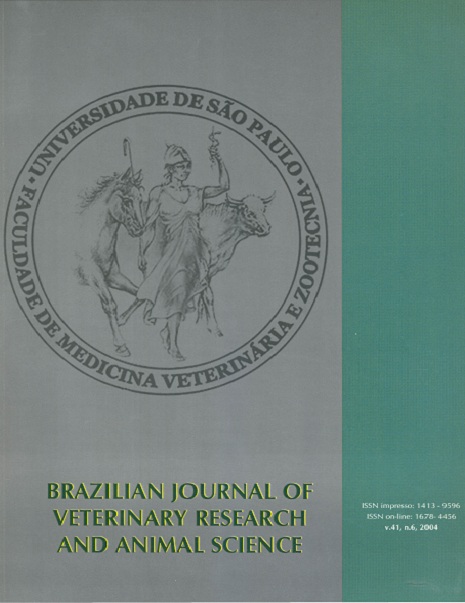Techinical implications of the vaccination in the immune response against the foot-and-mouth disease virus
DOI:
https://doi.org/10.1590/S1413-95962004000600003Keywords:
Immune response, Vaccination, Foot-and-mouth diseaseAbstract
In Brazilian cattle-breeding, the vaccination against the foot-and-mouth disease virus is essential during the early stages of disease erradication programmes. In spite of the official control on the vaccine quality, thecnical variables, as manipulation, transportation and conservation by the consumer, dosage, place and manner of inoculation that interfere with the immune response, remain unmonitered and are the concerns that guide this study.Titers of neutralizing antibodies to the foot-and-mouth disease virus were established in microtitration plates with BHK-21 cell culture, calculated in decimal logarithm, in sera from cattle vaccinated according to the protocol presented. Among 25 animals of the first group, the mean antibody titers were 2.37 and 2.19, respectively, 30 and 180 days after the inocculation of a vaccine manipulated by specialized people, adopting all the recomended technical cares. Another group, with 140 cattle from 5 different farms, showed mean antibody titers of 1.66 and 1.51, respectively, 30 and 180 days after the inoculation of a vaccine manipulated without technical monitoring and by unspecialized people. Finally, a third group with 10 unvaccinated animals had mean antibody titers of 0.82 and 0.81 respectively, 30 and 180 days after the inoculation of a placebo. So, only the control of the vaccine quality was not enough to give to the herds satisfactory protection against the foot-and-mouth disease virus, since the literature considers that, in herds with a mean titer of 1.52, 50% of the animals are protected, and 70% of the animals in herds with mean titer of 1.70 are protected for a period of 7 months.Downloads
Download data is not yet available.
Downloads
Published
2004-11-01
Issue
Section
UNDEFINIED
License
The journal content is authorized under the Creative Commons BY-NC-SA license (summary of the license: https://
How to Cite
1.
Samara SI, Buzinaro M da G, Carvalho AAB de. Techinical implications of the vaccination in the immune response against the foot-and-mouth disease virus. Braz. J. Vet. Res. Anim. Sci. [Internet]. 2004 Nov. 1 [cited 2024 Nov. 12];41(6):375-8. Available from: https://revistas.usp.br/bjvras/article/view/6302





